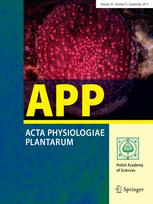Ver ítem
- xmlui.general.dspace_homeCentros Regionales y EEAsCentro Regional La Pampa - San LuisEEA AnguilArtículos científicosxmlui.ArtifactBrowser.ItemViewer.trail
- Inicio
- Centros Regionales y EEAs
- Centro Regional La Pampa - San Luis
- EEA Anguil
- Artículos científicos
- Ver ítem
Occurrence of powdery mildew disease in wheat fertilized with increasing silicon doses: a chemometric analysis of antioxidant response
Resumen
Blumeria graminis (Bgt) is a pathogenic fungus that affects severally wheat plants provoking high losses in wheat production. Biochemical parameters like enzyme activity of catalase, superoxide dismutase, or peroxidases can be used to detect changes of metabolism in response to pathogen infection. We evaluated different biochemical and biometrics parameters to assess the effect of silicon, a widely recognized beneficial nutrient, in wheat infected
[ver mas...]
Blumeria graminis (Bgt) is a pathogenic fungus that affects severally wheat plants provoking high losses in wheat production. Biochemical parameters like enzyme activity of catalase, superoxide dismutase, or peroxidases can be used to detect changes of metabolism in response to pathogen infection. We evaluated different biochemical and biometrics parameters to assess the effect of silicon, a widely recognized beneficial nutrient, in wheat infected naturally with Bgt. Integral study and interpretation of results obtained by multivariate analysis is the challenge of present work. Wheat plants growing in hydroponic solution were fertilized with increasing concentration of silicon. Responses of wheat plants to silicon treatments were assessed through the analysis of lipid peroxidation and antioxidant enzymes activity (catalase, ascorbate peroxidase and superoxide dismutase). Furthermore, biometric measures such as Pathogen Index, dry weight of shoot and roots, tiller height, spike length, spike mass, grain number and grain mass production were assessed. Pathogen Index decreased while mass and number of grain, dry weight of shoots were significantly increased, proportionally to silicon concentration increasing in culture media; biochemical parameters were also influenced by the concentration of silicon. Multivariate analysis indicated correspondence between increase of silicon treatments and decrease of antioxidant activities of APX, CAT and SOD. Relationships between the applied doses of silicon and decreasing Bgt expansion in foliar surfaces were also observed. Chemometrics proved to be an optimal tool for integrating data about metabolic status and demonstrate, in present case, that increasing concentration of silicon and the reduction of antioxidant enzyme activity are closely related to decreasing of powdery mildew disease.
[Cerrar]

Autor
Moldes, Carlos Alberto;
Lima Filho, Oscar Fontão de;
Merini, Luciano J.;
Tsai, Siu M.;
Camiña, José Manuel;
Fuente
Acta physiologiae plantarum 38 : 206. (August 2016)
Fecha
2016-08
Editorial
Springer
ISSN
0137-5881
1861-1664 (Online)
1861-1664 (Online)
Formato
pdf
Tipo de documento
artículo
Palabras Claves
Derechos de acceso
Restringido
 Excepto donde se diga explicitamente, este item se publica bajo la siguiente descripción: Creative Commons Attribution-NonCommercial-ShareAlike 2.5 Unported (CC BY-NC-SA 2.5)
Excepto donde se diga explicitamente, este item se publica bajo la siguiente descripción: Creative Commons Attribution-NonCommercial-ShareAlike 2.5 Unported (CC BY-NC-SA 2.5)

